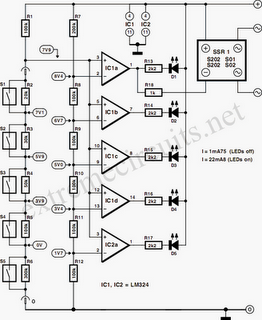Home » Circuits
Rainwater Storage Gauge
Not only on ecologically grounds but also economically it makes sense to collect rainwater for use in the garden and increasingly for `grey water` domestic use. People who take rainwater collection seriously use large underground tanks for storage. The problem now arises, how can the water level be determined without lifting the tank hatch and peering in? One solution is to use float switches mounted at different heights in the water tank, and to use a row of LEDs mounted remotely to show the water level in the tank. Transferring this information to a remote display will involve long cable runs so it is of interest to reduce the number of cables to a minimum.The circuit here shows how information about the water level in a tank can be sent over two wires to a remote LED display. R1 together with the resistor chain made up of R2-R6 form a voltage divider, float switches are wired across the resistors R2-R6 in one arm of the voltage divider. As water flows into the tank and the level rises, switch S5 closes followed by S4, etc. Each time a switch closes, it will short out its parallel resistor in the chain thereby changing the output voltage of the divider. When the tank is full, all five switches will be closed and all the LEDs will be on. The voltage output from this divider chain is applied to the inputs of five op amps that are configured as comparators.
 A voltage chain comprising R7-R12 supplies the reference voltage for each of the five comparators. Both divider chains use the same supply so they will be insensitive to supply fluctuations. The maximum supply current for the circuit is less than 25mA. Some of the resistors chosen to make up the voltage dividers are not standard values but can be easily made up from combinations of 10kΩ and 100kΩ resistors. If you need to expand this five level display to give a better resolution of the tank contents, it is a simple job to add more float switches and to expand the voltage divider chain. IC2 also has three spare op amps; these can be pressed into service as further comparators.
A voltage chain comprising R7-R12 supplies the reference voltage for each of the five comparators. Both divider chains use the same supply so they will be insensitive to supply fluctuations. The maximum supply current for the circuit is less than 25mA. Some of the resistors chosen to make up the voltage dividers are not standard values but can be easily made up from combinations of 10kΩ and 100kΩ resistors. If you need to expand this five level display to give a better resolution of the tank contents, it is a simple job to add more float switches and to expand the voltage divider chain. IC2 also has three spare op amps; these can be pressed into service as further comparators.
Underground tanks inevitably require a pump to move the water to where it will be used. An optional feature of this design is the pump protection circuit. When LED D1 goes off indicating that the tank is almost empty, the solid state relay SSR1 can be used to switch off the mains power to the pump. This will prevent damage to the pump when the tank runs dry. The S202 SE1 solid-state relay (SSR) from Sharp has an isolation voltage between its input and output of 3000V (Class 1). It is important to note here that any mains equipment near the water tank installation must be supplied from an RCD safety socket for the sake of your own health!
